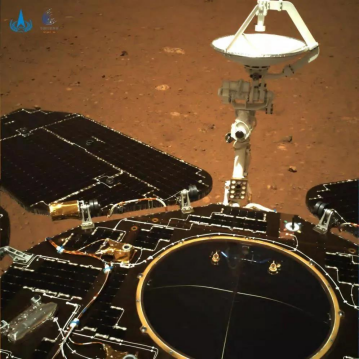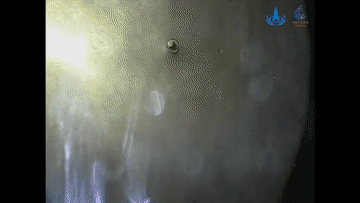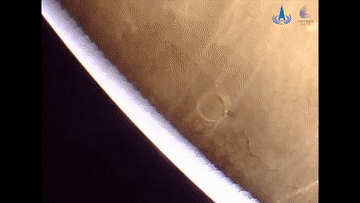HIT News---On May 19, CNSA released the images taken by the Mars rover after the landing process and the separation of the two instruments of China's first Mars mission probe Tianwen 1. In the images, the landing platform, the entrance ramp of Zhurong Mars Rover, the solar wing, antenna and other mechanisms are deployed properly in place.

△Photoed by the Mars Rover Front Obstacle Avoidance Camera, directly in the direction of the rover's advance. The image shows that the ramp mechanism deploys normally; the two reach bars at the top of the image are subsurface radars that have been deployed in place; and the terrain in the forward direction is clear. To obtain a larger range of terrain information in the direction of the Mars rover, the obstacle avoidance camera uses a large wide-angle lens, and the distant horizon forms an arc under the influence of wide-angle lens distortion.
The instrument-grade aluminum-based silicon carbide composite material (SiC/Al) developed by Prof. Wu Gaohui's team in the School of Materials is a new generation of space structure material specially designed for space environment, with the characteristics of low density, high stiffness, high thermal conductivity, good match between expansion coefficient and bearing, and dimensional stability in space environment. The dual-axis antenna driving mechanism for the Zhurong Rovrer has been tested under severe mechanical, thermal, and extreme high and low temperature environments, and has achieved consistency between pointing accuracy and position accuracy in heaven and earth, solved the light weight problem and other problems.

Photoed by the navigation camera, with the camera pointing towards the rear of the Mars rover. The image shows that the Mars rover solar wing and antenna are properly deployed in place; the surface texture of Mars is clear and the geomorphological information is abundant. One of the white mechanisms is the Zhurong Rover dual-axis antenna with aluminum-based silicon carbide composite drive mechanism, which has obtained precise directional positioning.
On May 15, the Mars rover established ground communications after the Tianwen 1 probe successfully soft-landed on the pre-selected landing zone in the southern part of the Martian Utopia Plain. On May 17, the orbiter applied the fourth near-fire brake and entered the relay communication orbit, establishing a stable relay communication link for the Mars rover and sending back image data one after another. At present, the Mars rover is being prepared to drive away from the landing platform, which will be opportune to drive on the surface of Mars to start roving exploration.


Image of the landing rover separation process taken by the orbiter's surveillance camera.
The Tianwen-1 orbiter and the Mars rover each carry a magnetic field detection payload to probe the magnetic fields in Mars space and in the landing zone, respectively. The Laboratory of Planetary Science of Institute of Space Science and Applied Technology from HIT(Shenzhen) participated in the development of the magnetic field detection payload of the Tianwen-1 orbiter and the subsequent calibration of the magnetic field data, and cooperated with the team of University of Science and Technology of China to develop the precise measurement technology of the magnetic field of non-magnetically controlled satellites, solving the problem of measuring the weak magnetic field in space and contributing to the acquisition of planetary space magnetic field data with independent intellectual property rights in China. The research will provide strong support for the study of Mars evolution and comparative planetology.
The spacecraft control team of Automation Department of School of Mechanical Engineering and Automation from HIT (Shenzhen) participated in the demonstration and review of the orbital transfer control scheme of Tianwen-1 Mars Rover, and the research results provided strong support for Mars Rover orbit braking and subsequent Mars orbiter return. They proposed the trajectory control method of Mars probe orbit transfer, aerodynamic capture orbit optimization, orbit holding control and other technologies, and cooperated with 803 Institute of Shanghai Spaceflight to carry out the research of ascent control and rendezvous control algorithm review and recalculation after the Mars probe orbiter finished sample sampling, contributing to the design and control of rendezvous capture orbit near Mars, design and control of sample return orbit and other program demonstration. The research team has contributed to the design and control of the rendezvous capture orbit near Mars and the design and control of the sample return orbit.
Under the success of the Mars Exploration Mission, there are not only a number of technical achievements contributed by the scientific research team from HIT, but also a group of HITers who have made contributions .
Li Maodeng, deputy chief designer of the guidance and control subsystem of the entry module of Tianwen-1, is an alumnus of the School of Astronautics of HIT. With excellent grades and aspirations to serve the country in aerospace, he chose to major in Aircraft Environment and Life Support Engineering at HIT, and won the first prize in the National Student Mathematical Modeling Competition (Northeast Provinces) during his undergraduate years. In 2006, he was admitted to the undergraduate program of aircraft design under the supervision of Prof. Jing Wuxing, and was awarded the "12th Outstanding Doctoral Dissertation in Progress of HIT". After graduation in 2011, he joined 502 Institute of Astronautics of the Fifth Academy of Astronautics as a postdoctoral fellow, his cooperation supervisor being Wang Dayi, a National Outstanding Youth and an alumnus of HIT, whose research interests are autonomous navigation technology for deep space probes. After his postdoctoral studies, Maodeng Li has been engaged in the pre-research work in the field of autonomous navigation of spacecraft and the development of Tianwen-1. He is responsible for the design of autonomous navigation schemes and algorithms for Mars entry, descent and landing processes, and was selected as one of the first batch of young top-notch talents in Institute 502.

Li Maodeng interviewed by the media
The story of HIT and Tianwen-1
To be continued


